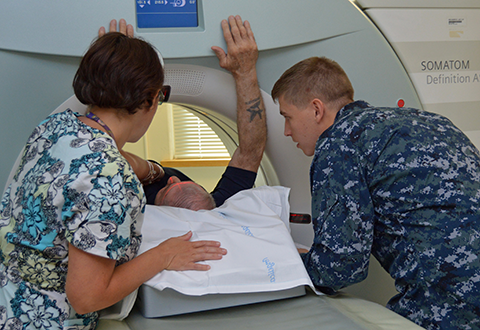VA New England Healthcare System
VA-DOD Training Partnership at Providence VAMC

Anna Almeida-Tenreiro, a radiology technologist at Providence VA Medical Center, and Navy hospital corpsman Petty Officer 3rd Class Kanoa LaVoun prepare World War II Navy Veteran Hector R. Rosado for a computerized tomography, or CT, scan at Providence VAMC, Sept. 11, 2015. (Providence VA Medical Center photo by Winfield Danielson)
Many Veterans come to Providence VA Medical Center after military service, but some come while still in uniform. Often they come for medical board evaluations or care relating to a service-connected injury, but some, like Navy hospital corpsmen Petty Officer 3rd Class Kanoa LaVoun and Petty Officer 1st Class Maria Luz Periabras, come for training.
"We're a small clinic," said LaVoun of his facility on Naval Station Newport, in Newport, R.I. "We do basic X-rays, but we don't have an MRI or CT machine. Here at the VA, they have CT and MRI."
Computerized tomography, or CT, and magnetic resonance imaging, known as MRI, allow health care professionals to produce images from areas inside the body to help make diagnoses and develop treatment strategies.
Five Navy diagnostic radiologic technologists from Newport and Naval Submarine Base New London, in Groton, Conn., are rotating through Providence VAMC's Diagnostic Imaging Service two to three days per week in CT, MRI and ultrasound, another diagnostic imaging technique.
"Providence VA just got new ultrasound machines last year," said Periabras. "The equipment we work with is like cell phones in that they advance every two or three years, and this training partnership helps keep us current."
The training partnership also helps the Navy techs develop skills needed for future assignments.
"The skills we learn here will provide more opportunities, but they also make me more knowledgeable in general about my job," LaVoun said, noting that there were other differences besides the equipment. "You have inpatients here with different conditions; Newport is all outpatient."
The partnership is also a win for VA, according to Susan Neimic, Radiology Administrator at Providence VAMC, who coordinates the program with Periabras. "The trainees are working toward certification that could help them with employment after military service - we hope at VA! We want to increase the number of Veteran employees."
















